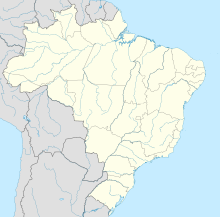Marechal Rondon International Airport
Várzea Grande–Marechal Rondon International Airport Aeroporto Internacional de Várzea Grande–Marechal Rondon | |||||||||||
|---|---|---|---|---|---|---|---|---|---|---|---|
 | |||||||||||
 | |||||||||||
| Summary | |||||||||||
| Airport type | Public | ||||||||||
| Operator |
| ||||||||||
| Serves | Cuiabá, Várzea Grande | ||||||||||
| Location | Várzea Grande, Brazil | ||||||||||
| Focus city for | Azul Linhas Aéreas Brasileiras | ||||||||||
| Time zone | BRT−1 (UTC−04:00) | ||||||||||
| Elevation AMSL | 188 m / 617 ft | ||||||||||
| Coordinates | 15°39′00″S 056°07′03″W / 15.65000°S 56.11750°W | ||||||||||
| Website | centroeste-airports | ||||||||||
| Map | |||||||||||
| Runways | |||||||||||
| |||||||||||
| Statistics (2022) | |||||||||||
| |||||||||||
Várzea Grande–Marechal Rondon International Airport (IATA: CGB, ICAO: SBCY) is the airport serving Cuiabá, Brazil, located in the adjoining municipality of Várzea Grande. It is named after Marshall Cândido Mariano da Silva Rondon (1865–1958), a Brazilian explorer.
It is operated by Aeroeste.
History[edit]
This section needs to be updated. (January 2020) |
Marechal Rondon International Airport was inaugurated in 1956 but operated precariously until the first passenger terminal building was completed in 1964.
Infraero became the operator of the airport in 1974, and in 1996 it was upgraded to international status.
The first phase of the construction of the new passenger terminal was completed on 30 June 2006. The second phase would involve the demolition of the old terminal building and the construction of the enlargement of the new passenger terminal on its place.

On 31 August 2009, Infraero unveiled a BRL30.9 million (US$16.3 million; EUR11.4 million) investment plan[5] to up-grade Marechal Rondon International Airport focusing on the preparations for the 2014 FIFA World Cup which was held in Brazil, Cuiabá being one of the venue cities. The investment was distributed in the renovation of the passenger terminal, parking and access to the airport.
Responding to critiques to the situation of its airports, on May 18, 2011, Infraero released a list evaluating some of its most important airports according to their saturation levels. According to the list, Cuiabá was considered to be critically saturated, operating above 85% of its capacity.[6]
On March 15, 2019, Aeroeste won a 30-year concession to operate the airport.[7]
Airlines and destinations[edit]

Accidents and incidents[edit]
- 30 March 1980: a VOTEC Britten Norman BN-2A-9 Islander registration PT-JSC stalled and crashed upon take-off from Cuiabá. All 9 occupants died.[8]
- 23 June 1985: a TABA Embraer EMB 110 Bandeirante registration PT-GJN flying from Juara to Cuiabá, while on approach to land at Cuiabá, had technical problems on engine number 1. An emergency landing was attempted but the aircraft stalled and crashed 1 km short of the runway. All 17 occupants died.[9][10]
Access[edit]
The airport is located 10 km (6 mi) from downtown Cuiabá.
See also[edit]
References[edit]
- ^ "Estudos e Estatísticas". Centro-Oeste Airports (in Portuguese). Retrieved 5 June 2023.
- ^ "Aeroporto Internacional de Cuiabá - Marechal Rondon - CGB". Centro-Oeste Airports (in Portuguese). Retrieved 5 June 2023.
- ^ "Aeródromos". ANAC (in Portuguese). 15 October 2019. Retrieved 28 April 2020.
- ^ "Marechal Rondon (SBCY)". DECEA (in Portuguese). Retrieved 19 November 2023.
- ^ Rittner, Daniel; Braga, Paulo Victor (31 August 2009). "Infraero vai gastar R$5 bi em reforma de aeroportos". Valor Econômico (in Portuguese). pp. A4.
- ^ "Governo muda critério de avaliação e 'melhora' desempenho de aeroportos" (in Portuguese). O Estado de S. Paulo. 19 May 2011. Retrieved 20 May 2011.
- ^ "Governo obtém R$ 2,377 bilhões em concessão de aeroportos em blocos". ANAC (in Portuguese). 15 March 2019. Retrieved 5 October 2019.
- ^ "Accident description PT-JSC". Aviation Safety Network. Retrieved 25 September 2012.
- ^ "Accident description PT-GJN". Aviation Safety Network. Retrieved 6 August 2011.
- ^ Germano da Silva, Carlos Ari César (2008). "Obstáculo imprevisto". O rastro da bruxa: história da aviação comercial brasileira no século XX através dos seus acidentes 1928–1996 (in Portuguese) (2 ed.). Porto Alegre: EDIPUCRS. pp. 342–344. ISBN 978-85-7430-760-2.
External links[edit]
- Airport information for SBCY at Great Circle Mapper. Source: DAFIF (effective October 2006).
- Current weather for SBCY at NOAA/NWS
- Accident history for CGB at Aviation Safety Network


 French
French Deutsch
Deutsch